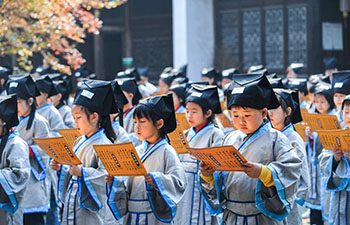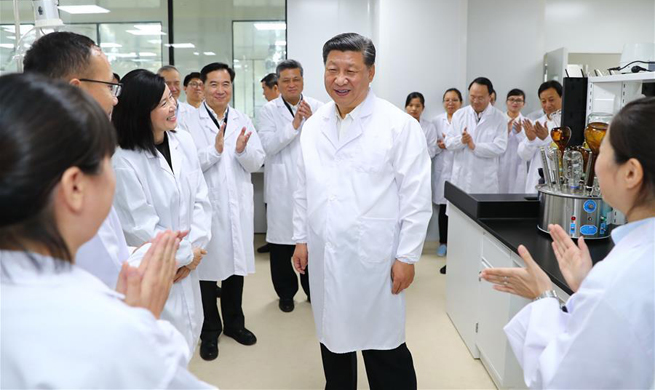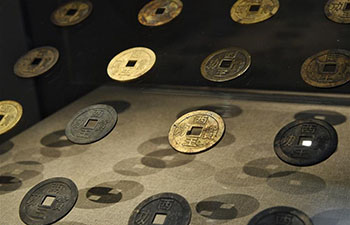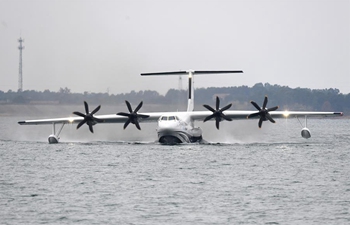by Zhu Yuxuan, Li Binbin, Yan Hao
HONG KONG, Oct. 23 (Xinhua) -- Lying in the Lingdingyang Bay like a giant dragon, the world's longest cross-sea bridge, the Hong Kong-Zhuhai-Macao Bridge (HZMB), was officially opened in China's southern Zhuhai city on Tuesday.
The bridge, linking China's Hong Kong Special Administrative Region (SAR), Macao SAR and Zhuhai in Guangdong province, will act as a new transport artery for the three places and the Greater Bay Area.
On the west and east sides of the bridge, 83-year-old industrialist Gordon Wu Ying-sheung and 61-year-old engineer Lin Ming both looked out at the long-stretching bridge across the sea.
Wu, one of the first Hong Kong entrepreneurs bringing investment to the mainland since China's reform and opening-up, got the idea of such a bridge decades ago.
Back in 1983, Wu proposed a plan to build a bridge across the waters of Lingdingyang of Pearl River Estuary to link Hong Kong and Zhuhai. He envisaged that a bridge-tunnel began at the west bank of Hong Kong and crossed the Pearl River Estuary via two natural islands, and ended at the east bank of Zhuhai.
The plan drew attention of the mainland but was denied by the then British Hong Kong government. "Unfortunately, discussion about this bridge stalled," Wu said.
However, Wu's proposal had won admiration from bridge engineers in the Chinese mainland. Lin was among them.
In 2006, Lin led his team to Hong Kong to discuss the construction of the HZMB, and met Wu for the first time.
The second meeting between the two took place on a hot summer day in July 2011, two years after the official ground-breaking of the bridge.
"Mr. Wu took an early ferry from Hong Kong to Zhuhai for discussion about generating electricity of the bridge with tidal power, in such a scorching day. With fame and fortune in hand, Wu never ceased his attempt to contribute more even he was almost 80!" said Lin.
"I was so touched and motivated," he added.
With a total length of 55 km, the HZMB was termed as "Mount Qomolangma in the field of infrastructure construction." It's not only the world's longest sea crossing, the world's first undersea immersed tunnel, but also the world's largest offshore bridge-cum-tunnel project.
Building immersed tunnel offshore is a world-class technique mastered by very few countries. During the preparation period, Lin led study tours abroad to learn about the techniques. However, some foreign experts asserted that China was not capable of building the bridge and charged 150 million euros (172 million U.S. dollars) as the consulting fee.
"We realized that innovation is a must to achieve our goal to build the Hong Kong-Zhuhai-Macao Bridge," said Lin.
Day in and day out, Lin and his team immersed themselves in the office for years. "With all these sufferings thwarting us, we never stopped trying. And finally we accomplished this unprecedented project," said the engineer.
For his part, Wu gave Lin full appreciation for his work. "Lin did a brilliant job. Forty years ago, China was lack of experience in bridge construction. But now I'm confident to say that Lin's work has reached the world's leading level. And China is showing more competitiveness for its low cost in construction," said Wu.
On Feb. 4, Wu was invited to a seminar on the HZMB, where he met Lin for the third time.
That day also marked the first time Wu had a thorough look at the mega bridge after his proposal was made 35 years ago.
"It's extraordinary! " said Wu. "I'm thrilled to see this high-quality construction by our domestic engineers and construction teams. My dream has come true."
"Bearing the spirit of engineering and craftsmanship in mind, we live up to the expectation," Lin said.
On Tuesday, Wu was invited to Zhuhai, the west part of the HZMB, to witness the opening ceremony of the bridge, while Lin was assigned to the east artificial island of the bridge.
"Although we are unable to meet today, the bridge brings more people from the three places to meet instead," said Lin.

















